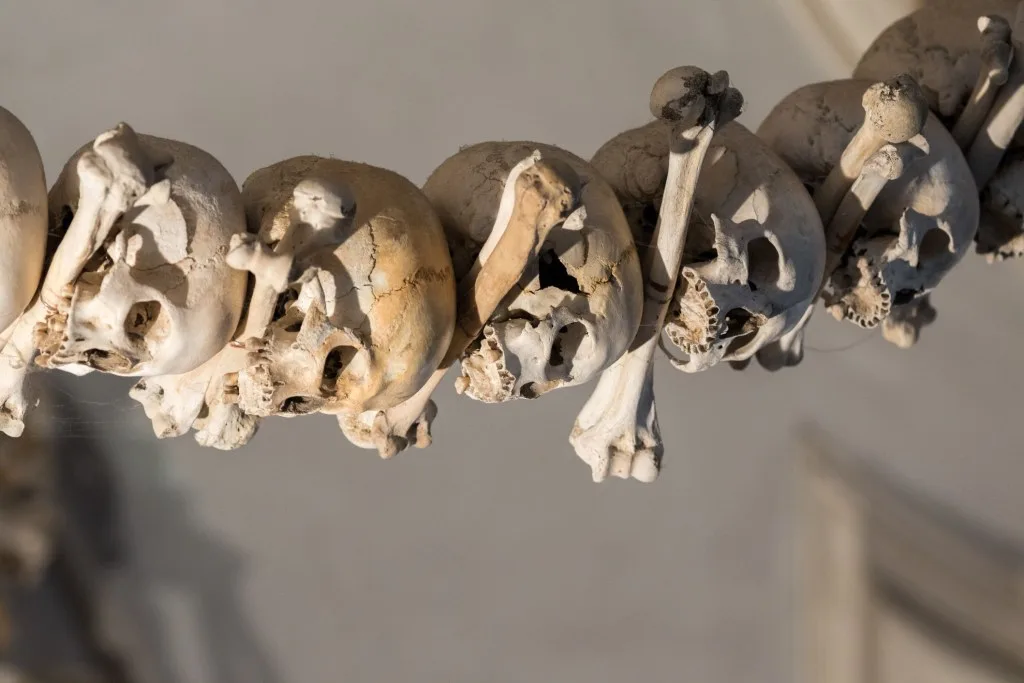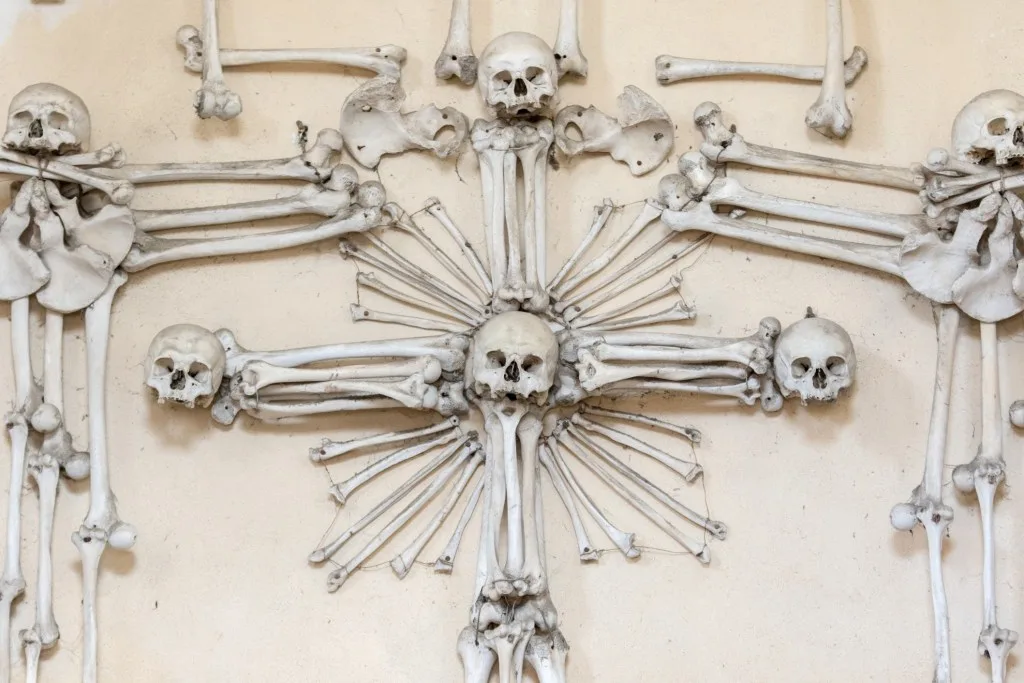Living in the United States, you may have never heard of an ossuary. For around 1,200 years, these unique graves were part of death rituals around the world. But they fell out of fashion around the 19th century.
If bones, graves, and history strike your fancy, you’ll likely dig this information.
We’ll share the somewhat morbid details about these ancient burial sites. Afterward, you can determine whether a visit to one is right for you.
Let’s unearth some facts!
What is an Ossuary?
Ossuaries are repositories for human bones. Most of the remains placed in ossuaries are on their second burial.
Typically, a primary burial site held the deceased bodies until only their bones remained. Low-temperature cremation often caused bodies to decompose, leaving just the bones.
Ossuaries are unique because they mostly hold the remains of many people rather than individuals. These secondary graves often have the bones of soldiers killed on the battlefield or mass casualties from genocide.
Limited burial space is another reason ossuaries were common. If a town didn’t have enough room for individual graves, these group burials took up much less space.
Ossuaries also served to honor the dead. Ancient Zoroastrians used astudans (a place for bones), or underground wells, for their burial practices. Roman Catholics, Eastern Orthodox Christians, and Jews all have a tradition of ossuaries for venerated figures.
Bones arranged for public viewing and honoring the deceased in this way may seem strange to us now. But for our ancestors, this practice reminded them of their past.

History of Ossuaries
Ossuaries played an essential role in how past cultures respected their dead. Individual sites hold the remains of high-ranking people such as saints and kings. But much more common are rooms where bones are displayed en masse.
And while you can find ossuaries around the world, they’re primarily associated with Eastern Orthodox and Catholic traditions.
Some archeologists suggest that the Bronze Age chambered tombs were precursors to ossuaries.
Whatever the case, the Persian astudans are the earliest examples of these graves. Jewish ossuaries were common from 600 BC into the early 1st century. Reserved mainly for the wealthy, burial in a limestone ossuary box near Jerusalem was an honor.
Europeans turned ossuaries into works of art beginning in the 12th century. Due to plagues and exploding populations, bodies started piling up. One solution was to dig up the older bones to make room for the recently deceased.
Piles of bones aren’t aesthetically pleasing, so artists stepped in. They created sculptures of arranged skulls and mosaics from the bones of those long-departed.
If you aren’t too disgusted yet, our list of ossuaries around the world may even intrigue you. Your next vacation could include a visit to one of these ancient burial sites.
Pro Tip: Do you enjoy visiting spooky spots? Check out these 13 Most Haunted Places in the U.S.

Where Are Ossuaries Located?
Most ossuaries are on the European continent due to the Catholic history over the centuries. You can find them in and around churches dating back to the early 12th century. We’ve put together some of the locations and details of the most interesting boneyards.
Brno Catacombs, Brno, Czech Republic – Rediscovered in 2001 behind a church wall, the second-largest ossuary in Europe dates back to the 17th century. Roughly 50,000 people are interred in the catacombs.
The Brno Catacombs are open every day of the week except Monday.
San Bernadino Alle Ossa, Milan, Italy – When a nearby cemetery ran out of space in 1210 CE, local authorities had to do something. They exhumed the bones of older burials to make space for the freshly dead. Twenty years later, they built a church to house the bones.
Remodeled in 1769, artists decorated the church walls with the skulls and bones of the dead. Visitors are welcome every day except Sunday.
The Beinhaus, Hallstatt, Austria – This “bone-house” is slightly different from the others. Beginning in the 12th century, family members painted flowers and the date of death on the skulls of the dead. The remains were placed in family groups.
Visitors are welcome from April through October.
St. Bride’s Crypt, London, England – This is one of the few ossuaries on British soil. Disturbed during the London Blitz of World War II, St. Bride’s contained bones dating back to the 1st century.
Roman soldiers and plague victims of the 17th century are together in the ossuary. Added on top are bones from the cholera epidemic of the 19th century.
Visitors must take a guided tour offered once a week to see this ossuary.
Are There Any Ossuaries in the US?
As far as we can tell, there’s only one ossuary in the United States. In the Cape Cod National Seashore around Wellfleet Harbor lies the Indian Neck Ossuary, dating back to approximately 1100 AD. This burial site held the remains of 56 individuals, excluding infants.
In 1979, a backhoe accidentally disturbed the burial ground while digging a trench for a building project. Once authorities determined the site wasn’t a mass grave, it became part of the National Parks Service.

Which One Is the Largest in the World?
The Catacombs of Paris make up the largest ossuary in the world. Paris is an ancient city, and there’s a network of tunnels underneath it. Initially, the tunnels were empty spaces after builders removed earthen material to begin construction.
In the 18th century, the tunnels started causing structural problems. Engineers shored up the passages to keep the buildings above safe.
Around the same time, city authorities began closing cemeteries. But where would they put the bones from the graveyards? The tunnels seemed a logical location.
Over six million people have their bones in the catacombs. Beginning in the 19th century, visitors flocked to the area. The Catacombs are still a popular tourist destination.
Pro Tip: In for a scare? Listen to these 7 Spooky Campfire Podcasts for Your Next RV Trip.
Is Visiting an Ossuary Worth It?
If reminders of death don’t cause problems for you, plan your trip now! In the United States, we have monuments to our recently deceased but nothing like the European ossuaries.
Make your way to these sites and feel the weight of human mortality or just appreciate the ingenuity of our forebears. A bit too much? Maybe visit a European winery instead.
Visit an Ossuary to Honor the Dead
Honoring those that came before us is a human tradition. Visiting one of these ossuaries is a great way to do just that.
But if a bony hand grabs your ankle while you’re walking down the path, don’t say we didn’t warn you.
Have you visited an ossuary? Tell us all about it in the comments below.
Discover the Best Free Camping Across the USA
To be honest with you, we hate paying for camping. There are so many free campsites in America (with complete privacy).
You should give it a try!
As a matter of fact, these free campsites are yours. Every time you pay federal taxes, you’re contributing to these lands.
Become a FREE CAMPING INSIDER and join the 100,000 campers who love to score the best site!
We’ll send you the 50 Best Free Campsites in the USA (one per state). Access the list by submitting your email below: